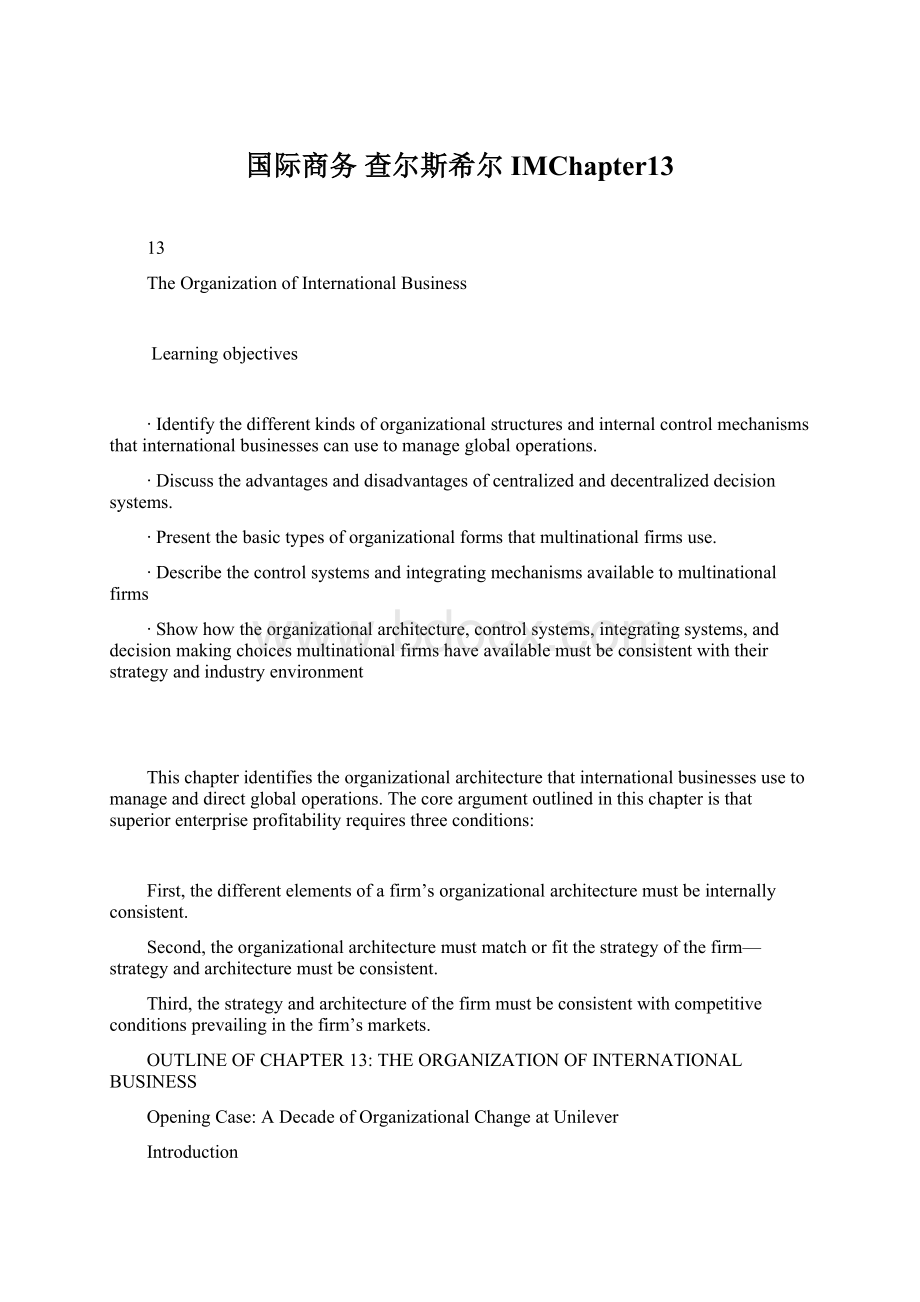国际商务 查尔斯希尔IMChapter13.docx
《国际商务 查尔斯希尔IMChapter13.docx》由会员分享,可在线阅读,更多相关《国际商务 查尔斯希尔IMChapter13.docx(10页珍藏版)》请在冰豆网上搜索。

国际商务查尔斯希尔IMChapter13
13
TheOrganizationofInternationalBusiness
Learningobjectives
∙Identifythedifferentkindsoforganizationalstructuresandinternalcontrolmechanismsthatinternationalbusinessescanusetomanageglobaloperations.
∙Discusstheadvantagesanddisadvantagesofcentralizedanddecentralizeddecisionsystems.
∙Presentthebasictypesoforganizationalformsthatmultinationalfirmsuse.
∙Describethecontrolsystemsandintegratingmechanismsavailabletomultinationalfirms
∙Showhowtheorganizationalarchitecture,controlsystems,integratingsystems,anddecisionmakingchoicesmultinationalfirmshaveavailablemustbeconsistentwiththeirstrategyandindustryenvironment
Thischapteridentifiestheorganizationalarchitecturethatinternationalbusinessesusetomanageanddirectglobaloperations.Thecoreargumentoutlinedinthischapteristhatsuperiorenterpriseprofitabilityrequiresthreeconditions:
First,thedifferentelementsofafirm’sorganizationalarchitecturemustbeinternallyconsistent.
Second,theorganizationalarchitecturemustmatchorfitthestrategyofthefirm—strategyandarchitecturemustbeconsistent.
Third,thestrategyandarchitectureofthefirmmustbeconsistentwithcompetitiveconditionsprevailinginthefirm’smarkets.
OUTLINEOFCHAPTER13:
THEORGANIZATIONOFINTERNATIONALBUSINESS
OpeningCase:
ADecadeofOrganizationalChangeatUnilever
Introduction
OrganizationalArchitecture
OrganizationalStructure
VerticalDifferentiation:
CentralizationandDecentralization
HorizontalDifferentiation:
TheDesignofStructure
IntegratingMechanisms
ControlSystemsandIncentives
TypesofControlSystems
IncentiveSystems
ControlSystems,Incentives,andStrategyintheInternationalBusiness
Processes
OrganizationalCulture
CreatingandMaintainingOrganizationalCulture
OrganizationalCultureandPerformanceintheInternationalBusiness
Synthesis:
StrategyandArchitecture
LocalizationStrategy
InternationalStrategy
GlobalStandardizationStrategy
TransnationalStrategy
Environment,Strategy,Architecture,andPerformance
OrganizationalChange
OrganizationalInertia
ImplementingOrganizationalChange
ChapterSummary
CriticalThinkingandDiscussionQuestions
ClosingCase:
StrategicandOrganizationalChangeatBlack&Decker
TEACHINGSUGGESTIONS
Inordertogetstudentsthinkingaboutthetrade-offimplicitinanystrategicchoice,thissmallgrouporindividualexercisecanbeusedatthebeginningofclass.
You’vedevelopedverypopularup-scalebutreasonablypricedclothingfashionlineforyoungpeople,producingdesignsinanumberofcountries,manufacturinginlow-costlocations,andwithretailoutletsinmajorUSandEuropeancities.Demandispoppingandyouhaveaccesstoplentyofproductioncapacityandcapital.HowshouldyouorganizethebusinessoutsidetheU.S.?
Shouldyousetupreasonablyindependentcompanies,subsidiaries,ineachforeignmarket?
Whatwouldthatdoandnotdoforyou?
Ordoyouwanttoimposeastrictbrandimage,procedures,andcentralplanningfromheadquarters,whereyourofficesare?
Whataretheplussesandminusesofthatapproach?
TRANSITION
TheconnectionwiththeUnileverOpeningCaseisclear.Theybeganwithadecentralizedsystemandhavebeenrapidlymovingtowardsincreasingintegration.
∙Unileverisa$50billioncompanysellingmorethan1000productsinvirtuallyeverycountry.
∙HistoricallyUnileverwasorganizedintodecentralizedsubsidiariesineachmajornationalmarket.Intheearly1990stherewere17UnileversubsidiariesinEurope.
∙Decentralizationallowedlocalmanagerstorespondtoitsuniquemarketconditionsandwasasourceofstrength.
∙Unileverworkedhardtobuildacommonculturetoknittogetheradecentralizeddisparateorganization.
∙Bythemid1990sUnilever’sdecentralizedstructurewasworkingagainstitseffortstobuildglobalbrandsandcutcostsinthefaceofcompetition.
∙In1996Unileverintroducedanewstructurebasedonregionalbusinessgroups.
∙The17Europeancompaniesrelinquishedautonomyintheirmarketstohelpdevelopaunifiedpan-Europeanstrategy.
LECTUREOUTLINEFORCHAPTER13
ThisteachingoutlinefollowsthePowerPointpresentationprovidedalongwiththisinstructor’smanual.ThePPTslidesincludeextensivenotesthatareprintableunderview—notespage.Whatfollowsisasummary.
Slide13-3OpeningCase:
OrganizationalChangeatUnilever
Whenitsstructurewasdecentralized,Unileverusedmeetingsandconferencetocreateacommonculture.However,therewasstillalotofwasterelatedtoredundancyintheorganization.The1996reorganizationbyregionalbusinessgroupsandtheuseofprogramssuchasLeverEuropedevelopednewcapabilitiesincostreductionaswellasglobalproductintroduction.
Slide13-4Introduction
Organizationarchitectureincludesstructure,controlsystems,incentives,processes,cultureandpeople.Threeconsistencyconditionsmustbesatisfiedforanorganizationtodeliverprofitability:
architecturemustbeinternallyconsistent;strategyandarchitecturemustbeconsistent;strategyandarchitecturetogethermustbeconsistentwiththecompetitiveenvironmentofthefirm.
Slides13-5,13-6,13-7OrganizationalArchitecture
Structureandcontrolsystemsestablishdecision-makingresponsibilitiesandintegrationmechanisms.Controlsystemsmeasureandevaluatemanagerialperformanceandtheperformanceofsub-units.Incentivesconnecttocontrolsystems,andprocessesneedtobeconsistentwiththestrategicobjectivesoftheorganization.Effortstoshapevaluesandnormsinanorganizationareintricatelylinkedtohumanresourcepractices,especiallyattheselectionandrecruitmentstages.
Slide13-8OrganizationalStructure
Verticaldifferentiationlocatesdescision-making.Horizontaldifferentiationlocatescontrolboundaries(units/sub-units).Integratingmechanismsprovideforcoordination.
Slide13-9Centralizationv.Decentralization
Thetrade-offsherearecontrolandlocalresponsiveness.
Slide13-10HorizontalDifferentiation(HD)
Thetypicalentrepreneurialfirmbeginswithnoformalstructure.Asthefirmgrows,whenthedecisionloadbecomestoointenseforonepersontohandle,thefirmissplitintofunctionsrepresentingvaluecreationactivities.Ifgrowthcontinues,eventuallythecomplexitiesofsizepushforthere-structuringofthefirmintoadivisionalform.
Slide13-11TypicalFunctionalStructure
Slide13-12,13-13InternationalDivision
TheInternationalDivisionstructureisorganizedbygeography.
Slide13-14ProblemswiththeInternationalStructure
Thesehavetodowithconflictbetweenforeignanddomestic,foreignmanagersgivenasecondaryrole,andlackofcoordination.
Slide13-15InternationalStructuralStagesModel
Slides13-16,13-17WorldwideAreaStructure
Theworldisdividedintoareas.Anareamaybeacountryoragroupofcountries.Eachareaisself-containedandautonomous.Whilethisstructuresupportslocalresponsiveness,itcanleadtofragmentationbecauseoflackofcoordinationacrosstheareas.
Slides13-18,13-19WorldwideProductDivisionalStructure
Somefirmsshifttoaworldwideproductdivisionalstructureasinternationalgrowthincreases.Eachproductdivisionisautonomousandresponsibleforitsownvaluecreationactivities.Thisgivesmanagerslatitudetorealizelocationandexperiencecurveeconomies.However,areaorcountrymanagerstendtohavelittlevoiceinthisstructureandthiscanhaveadevastatingeffectonlocalresponsiveness.
Slides13-20,13-21GlobalMatrixStructure
Whenafirm’sstrategysimultaneouslydemandslocationandexperiencecurveeconomies,localresponsiveness,andinternaltransferofcorecompetenciestheglobalmatrixstructuredoesthebestjob.Itisanattempttosimultaneouslycapturethebenefitsoftheworldwideareastructureandtheworldwideproductdivisionalstructure.Thebalancingactoftheglobalmatrixstructurecomeswithitsownchallenges.Itslowsdowndecisionmaking,increasesthelikelihoodofconflictbetweentheareastructureandtheproductstructure,andaccountabilityisalwaysachallengewheneachmanagerhastowear2hats–onearea-specificandoneproduct-specific.
Slide13-22IntegratingMechanisms
Differentstrategiesmakedifferentdemandsonthemanagerintermsoftheneedforcoordination.
Slide13-23ImpedimentstoCoordination
Differinggoalsandlackofrespect;differentorientationsduetodifferenttasks;differencesinnationality,timezoneanddistance.
Slides13-24,13-25FormalIntegratingSystems
Directcontact,liaisonroles,teams,andmatrixstructures
Slides13-26,13-27InformalIntegratingMechanisms
Informalintegrationisawayaroundproblemswiththeformalsystems.Itrequirestheorganizationhaveateamworkspiritthatembracesasmanymanagersaspossibleinordertomakeinformalmechanismswork.Twocommontechniquesthatareusedtoestablishinformalnetworksare;
(1)theuseofanappropriatelydesignedinformationsystem
(2)theuseofmanagementdevelopmentpoliciesthatpromotenetworkbehavior.
Slide13-28Controlsystemsandincentives
Slide13-29FactorsthatInfluenceIncentiveSystems
(1)Theseniorityoftheemployeeandthenatureofworkdone
(2)Theoutputtargetsetfortheemployeeandthedegreeofinfluence(3)Theamountofcooperationbetweensubunitmanagers(4)Nationaldifferencesininstitutionsandculture.
Slides13-30,13-31PerformanceAmbiguity
Performanceambiguityexistswhenthecausesofasubunit’spoorperformancearenotclearanditiscausedbythehighdegreeofinterdependencebetweensubunitswithinthe